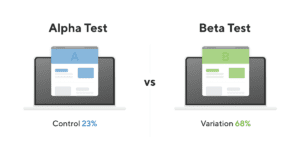What is an Alpha Test?
Alpha testing is the first end-to-end testing of a product to ensure it meets the business requirements and functions correctly. It is typically performed by internal employees and conducted in a lab/stage environment. An alpha test ensures the product really works and does everything it’s supposed to do. While “unit testing” and “smoke testing” of various individual components and features may have been conducted during the development process, an alpha test is an initial opportunity to evaluate the performance and comprehensive functionality of a given product release.
The primary difference between an alpha test and a beta test is who is doing the testing—alpha tests are typically performed by internal employees in a lab or stage environment, while beta tests are conducted by actual users in a production setting. The goal of the alpha test is to catch as many issues as possible before the product has any public exposure or usage.
Alpha tests can also be conducted using both “white box” and “black box” methods. In a white box setting, testers can “look inside” the product to see what’s happening during the testing, which is typically not possible in a production setting, while a black box test simply provides the inputs and confirms the outputs are returned as expected.
Because alpha testing occurs before the product is released, the white box view can provide additional insights to spot problems or troubleshoot bugs uncovered during the testing. Developers will typically immediately address issues discovered during alpha testing and update the test environment with fixes as soon as possible for additional testing.
Reliability and security testing are typically conducted during beta testing versus alpha testing because a stage/lab setting is not suitable for those environmental tests. The primary goal is to uncover “showstoppers” and other major bugs and issues as early as possible before moving forward with beta testing.
Who is Responsible for Alpha Testing?
Alpha testing will typically be coordinated by quality assurance or the software development team. Testers can include employees from across the company to get as many eyes on the product as possible, with the different tasks and test cases often split up among the various testers to ensure all use cases are covered and to expedite the process.
Testers will typically log issues in a bug tracking platform or communicate them directly to the development leads. The release cannot exit alpha testing until all major issues have been resolved and the product reaches “feature lock” where no additional functionality may be added.
Tips for Alpha Testing
Make the most of alpha testing by employing some of these tactics:
- Log every issue—Even if a decision is made to leave a bug or usability issue unresolved, capturing everything during the alpha test is a best practice as the development team can circle back to these items when time allows, or they can be ready and waiting in the backlog for post-release consideration.
- Don’t leave things until beta testing—Although beta testers might catch the same issue uncovered during alpha testing, there’s no guarantee that will happen. Plus the more items addressed during alpha testing means the product will look that much better to public beta testers and they won’t be distracted by known issues.
- Review the specs before testing—Anyone conducting alpha testing should review the functional specs and test cases before they get started. This provides context and a focus area for their work as well as establishing a baseline common understanding.
- Have the person who logged an issue do the retesting—The same person who found the bug should confirm that the issue is now resolved; don’t just take the developer’s word that it’s now fixed.
- Ensure there’s consensus before exiting alpha testing—Everyone involved in alpha testing should agree the product is ready for beta, providing a forum for anyone to raise concerns before the decision is finalized.
- Include non-technical employees—More tech-savvy people may be more forgiving of bugs and usability issues than typical users, so including a cross-section of representative users provides a more well-rounded review of the product during the alpha test.
- Test the entire user experience—A product may “work” but not be usable as part of a larger workflow, so test cases should include the end-to-end experience of a real-world user.
- Boot camp for sales and marketing—The alpha testing period is an excellent opportunity for the sales and marketing organizations to become more familiar with the latest iteration of the product. By actually using it to execute test scenarios, they will increase their understanding of the user experience and be able to communicate with much more authority when they’re presenting the product to the market.
- Practice reps for customer support—Alpha testing is a great chance for customer support to become intimately familiar with the changes and additions to the product before they’re dealing with real customers in a crisis. Including them in the testing is good preparation for them and provides an additional customer-focused lens on the product pre-release.
Takeaways
Alpha testing is an essential step in the product release process, although one that is sometimes bypassed in favor of moving directly to beta testing. Taking the time to review things internally can uncover a host of problems that could derail a beta test—or worse yet, escape discovery altogether—and always leads to a higher quality product being released to the market.
While an exhaustive and comprehensive review by employees may seem resource-intensive, nothing can replace the experience of a few extra sets of eyeballs reviewing a product’s functionality and ensuring things work smoothly. Alpha testing is a worthwhile investment of company resources and should be routine for any major release.
See Also: Beta Test